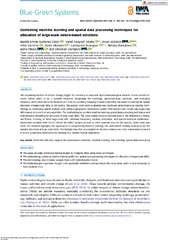Prikaz osnovnih podataka o dokumentu
Combining machine learning and spatial data processing techniques for allocation of large-scale nature-based solutions
| dc.creator | Gutierrez Caloir, Beatriz Emma | |
| dc.creator | Abebe, Yared Abayneh | |
| dc.creator | Vojinovic, Zoran | |
| dc.creator | Sanchez, Arlex | |
| dc.creator | Mubeen, Adam | |
| dc.creator | Ruangpan, Laddaporn | |
| dc.creator | Manojlovic, Natasa | |
| dc.creator | Plavšić, Jasna | |
| dc.creator | Đorđević, Slobodan | |
| dc.date.accessioned | 2023-12-25T09:20:31Z | |
| dc.date.available | 2023-12-25T09:20:31Z | |
| dc.date.issued | 2023 | |
| dc.identifier.issn | 2617-4782 | |
| dc.identifier.uri | https://grafar.grf.bg.ac.rs/handle/123456789/3350 | |
| dc.description.abstract | The escalating impacts of climate change trigger the necessity to deal with hydro-meteorological hazards. Nature-based solutions (NBSs) seem to be a suitable response, integrating the hydrology, geomorphology, hydraulic, and ecological dynamics. While there are some methods and tools for suitability mapping of small-scale NBSs, literature concerning the spatial allocation of large-scale NBSs is still lacking. The present work aims to develop new toolboxes and enhance an existing methodology by developing spatial analysis tools within a geographic information system (GIS) environment to allocate large-scale NBSs based on a multi-criteria algorithm. The methodologies combine machine learning spatial data processing techniques and hydrodynamic modelling for allocation of large-scale NBSs. The case studies concern selected areas in the Netherlands, Serbia, and Bolivia, focusing on three large-scale NBS: rainwater harvesting, wetland restoration, and natural riverbank stabilisation. Information available from the EC H2020 RECONECT project as well as other available data for the specific study areas was used. The research highlights the significance of incorporating machine learning, GIS, and remote sensing techniques for the suitable allocation of large-scale NBSs. The findings may offer new insights for decision-makers and other stakeholders involved in future sustainable environmental planning and climate change adaptation. | sr |
| dc.language.iso | en | sr |
| dc.relation | info:eu-repo/grantAgreement/EC/H2020/776866/EU// | sr |
| dc.rights | openAccess | sr |
| dc.rights.uri | https://creativecommons.org/licenses/by-nc-nd/4.0/ | |
| dc.source | Blue-Green Systems | sr |
| dc.subject | flood risk reduction | sr |
| dc.subject | arge-scale nature-based solutions | sr |
| dc.subject | machine learning | sr |
| dc.subject | NBS planning | sr |
| dc.subject | spatial data processing | sr |
| dc.title | Combining machine learning and spatial data processing techniques for allocation of large-scale nature-based solutions | sr |
| dc.type | article | sr |
| dc.rights.license | BY-NC-ND | sr |
| dc.rights.holder | autori | sr |
| dc.citation.issue | 2 | |
| dc.citation.spage | 186 | |
| dc.citation.volume | 5 | |
| dc.identifier.doi | 10.2166/bgs.2023.040 | |
| dc.identifier.fulltext | http://grafar.grf.bg.ac.rs/bitstream/id/12529/bgs0050186.pdf | |
| dc.type.version | publishedVersion | sr |

